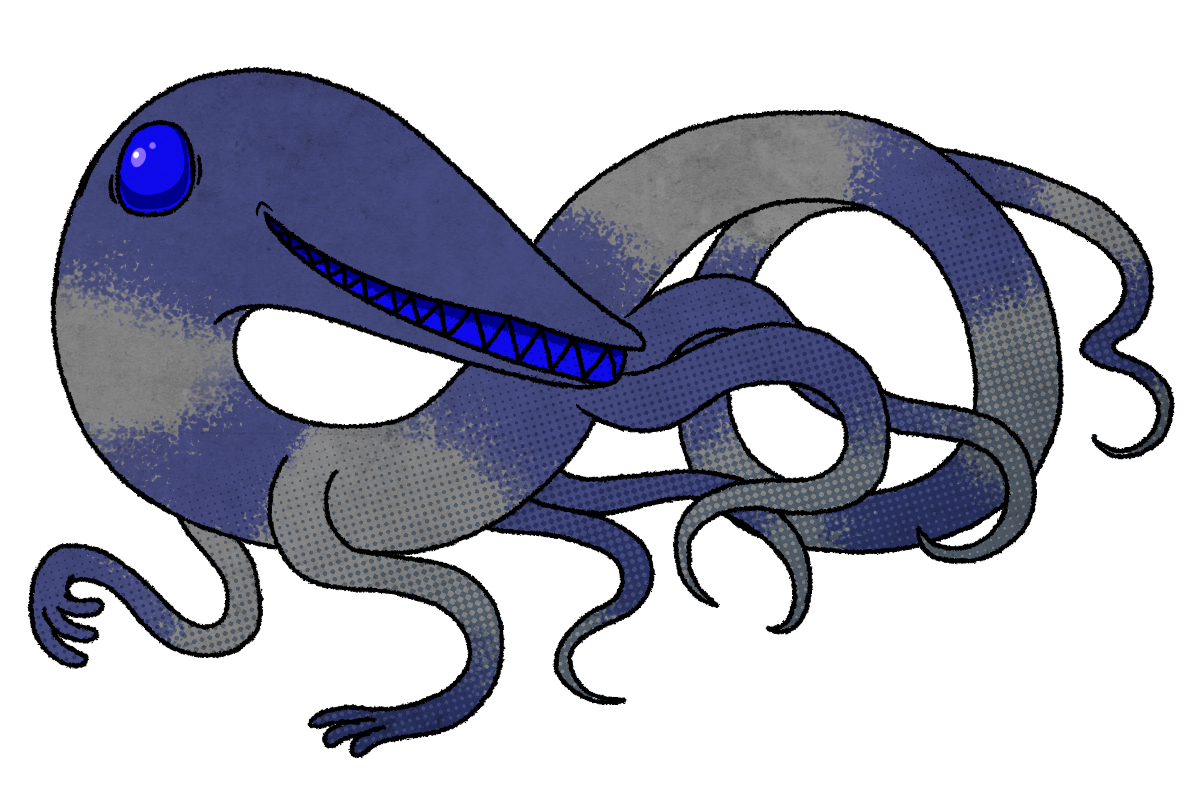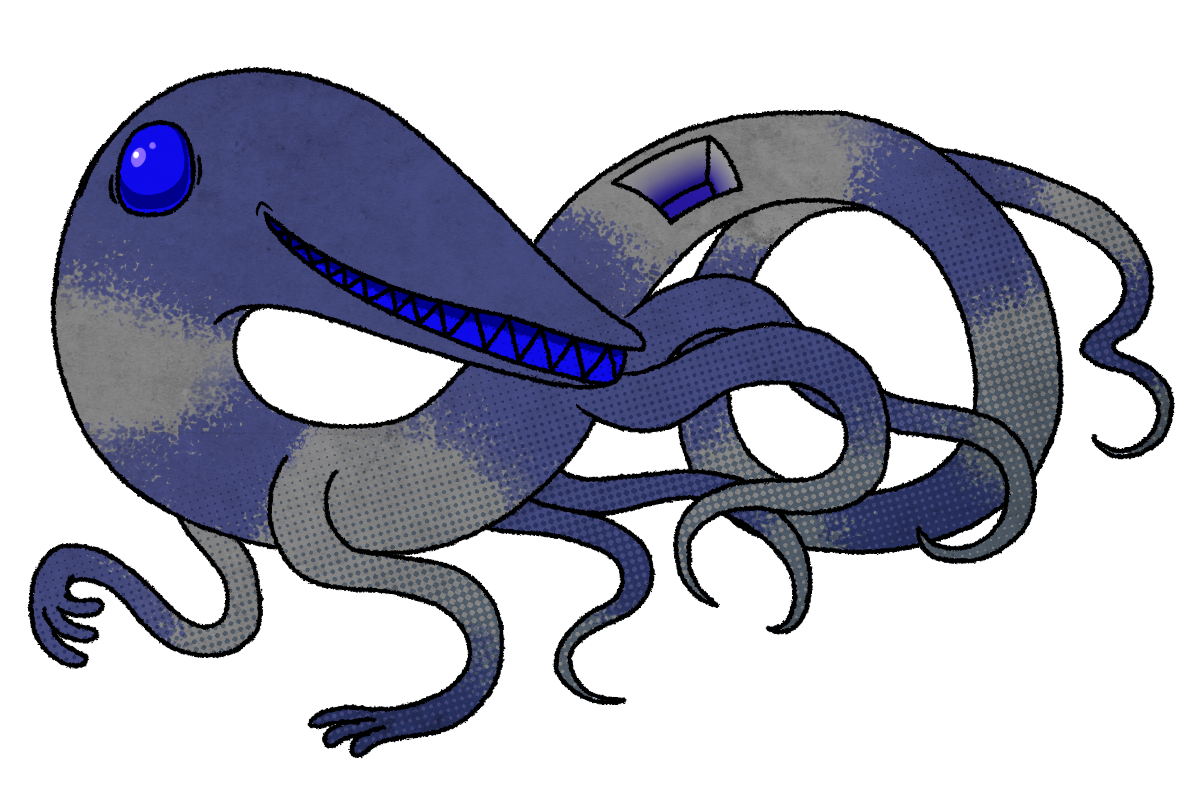


The irrevagranz is a moderately-sized stranger with a long, thin body, grey in color, with mottled, blotchy dull-blue stripes and a fairly long tail relative to its body length. Its eye markings bulge slightly from its form and are moderately reflective and glossy. It half-hovers in the air like a semiaquatic creature treading a riverbed- its front limbs are always in contact with the ground and it "walks" on them, but its hindquarters remain in the air at all times, tail and four hind tentacles twisting and flowing in the air as it moves. Its skin is matte and slightly worn in texture, like paper that's been exposed to the elements for a long time, while its inner flesh is slightly slick to the touch, and fades to a deep, vivid blue closer to the center. It has no odor at the start of its life, but as it ages, it begins to take on a faint vinegar-like smell, like old laminated paper.
The irrevagranz's skin is surprisingly durable and resists puncturing and blunt trauma, but is vulnerable to cutting from a place where it has already been punctured. For instance, attempting to stab an irrevaganz with a knife will take considerable force (at which point the knife will suddenly "pop" through the irrevaganz's skin), but after it has pierced the skin, cutting a line down its body takes much less effort. It heals rather slowly, with cuts and scrapes taking a few days to heal, and noticeable scarring in the form of damaged areas being rougher and lighter than the rest of its body.
It communicates through inorganic clicks, whirrs and chirps, like a printer.

The irrevagranz appears in outdoor, non-verdant locations, such as the streets and alleyways of cities. It will typically initially manifest in shaded areas, such as beneath awnings or decks, but open-air manifestations are not unheard of. Partly-cloudy skies, cool temperatures (around 58°F is ideal), and a prevalence of colorful imagery and advertising all increase the possibility of an irrevagranz infestation.
When the irrevagranz appears, its form slowly coalesces over the course of about two to four hours, with a longer generation time typically leading to a more stable individual. It hangs in the air, its grey body appearing first, with its blue stripes forming and spreading over its body after that. Once the formation of its stripes slows to a halt, it floats down to the ground like a feather, and trots off once its feet hit the ground.
1% of irrevagranz do not gain stripes during the formation process. These individuals form much quicker than their striped brethren (taking about 15 minutes to an hour), and have drastically lower stability, often collapsing and shriveling into a greyish clump within about five hours.
The irrevagranz is curious, excitable and somewhat flighty, wandering around its environment with the perpetual amazement of a tourist visiting a new city. Its disposition is punctuated by what appears to be quite a short attention span; even when standing still it cannot help but sway slightly in place and turn its head in different directions as its attention darts from one thing to the next. It most often speaks when it sees something that especially catches its attention, clicking with excitement when it spots a new, unworn store sign, for instance. It is not a particularly social strain, and though it often forms in groups, those groups will typically disperse with an inattentive wandering. They will give a greeting click or two to other irrevagranz they see, but will not form cohesive groups.
It seems to be at least somewhat interested in most things it sees in its perpetual sight-seeing, but it is particularly attracted to advertising and other printed imagery, such as billboards, flyers, and posters. When presented with objects of this sort, it will hover around them intently or pick them up if it can, whirring and buzzing curiously as it stares intently at the image, tracing its contours with its fingers as if trying to memorize and take in every last little detail. Any given irrevagranz can often be seen carrying a flyer in its hand, periodically stopping to look at it, before continuing on its wander.
As the irrevagranz intently stares into images that catch its eye, the color saturation of the images begins to fade, becoming more and more washed-out and worn, with a dull, teal-blue color persisting in the image's darkest areas. The effect can be most closely compared to old signage that has been severely sun-faded. When all pigment has been drained from an image, except for this blue color, the irrevagranz backs up (or drops the object), gives a nod of fulfillment and moves on.
The irrevagranz holds a curious, but somewhat nervous disposition towards sensitives. It likes to observe them from a distance, climbing up onto trees or light poles to get a good look at them from a safe vantage point, and it retreats when approached. Loud noises and sudden movements tend to startle it, but a stranger who simply relaxes, holds still and remains quiet will eventually be tentatively approached by the irrevagranz, as its curiosity overrides its fear. If allowed to, it may carefully paw at the sensitive's lap before climbing on and curling up for a few minutes. Eventually, however, it will appear satisfied with the human contact, and stands up, nods, and walks away.
Proximity to, and especially contact with, the irrevagranz causes colorblindness in sensitives. Initially identical in effect to deuteranopia colorblindness, the sensitive's ability to percieve red and green fades away over the course of a few days, before the ability to percieve yellow also fades over about a week and a half. A sensitive at the peak of this effect will only be able to see the color blue, with all else appearing as shades of faded, washed-out blue or grey.
A sensitive who was only near an irrevagranz, and did not allow it to touch them, is less likely to lose the ability to see yellow (with the full effect only manifesting in about 33% of these sensitives), and their sight will slowly fade back to normal over the course of about six months. A sensitive who made contact with the irrevagranz, however, is guaranteed to experience the full effect, and regains normal color vision over the course of roughly two and a half years. Those who entirely lose color vision in this way often report moderate distress and confusion upon regaining normal color vision, due to their brain becoming so used to its deficiency.
As it ages, the irrevagranz's color begins to fade, and its body shrivels, its papery skin wrinkling as it moves. As this happens, it begins to move in a slow and creaky manner, like an arthritic animal, while its quiet whirrs and clicks degrade into loud grinding buzzes. When its color fades entirely, it finally collapses with a long, drawn-out whine, akin to an old computer being turned off. Its body loses mass and crumples into a fragile sheet of papery matter, which does not decay on its own, but crumbles into fine dust under pressure.